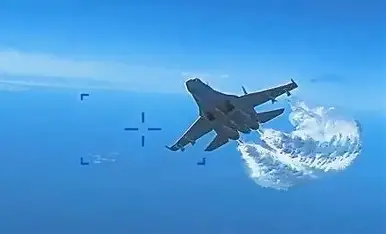Moscow, October 11, 2025
A Russian fighter jet crashed while attempting to land at a military airbase in southern Russia shortly before a coordinated drone attack was launched on the Ukrainian capital, Kyiv, early Saturday morning. The incident, confirmed by Russian defense sources and regional officials, underscores the growing strain on Russia’s air operations as the conflict enters another volatile phase.
According to preliminary reports, the aircraft, identified as a Su-34 strike fighter, went down during its final approach to the base in the Krasnodar region. Witnesses described a sudden flash of light followed by an explosion that shook nearby buildings as the jet hit the ground near the runway. Emergency responders arrived swiftly, but officials have not disclosed whether the pilots survived. Local authorities reported that the impact scattered debris across a wide radius and caused a fire near a nearby fuel storage facility before it was brought under control.
Russian state media attributed the crash to a “technical malfunction,” but defense experts suggest that wear, fatigue, and limited maintenance access due to Western sanctions are taking a toll on Moscow’s air fleet. The Su-34, a twin-engine bomber used heavily in long-range strike missions over Ukraine, has been operating under continuous deployment cycles for over two years, raising questions about equipment reliability and pilot safety.
Shortly after the crash, Ukrainian air defenses reported intercepting more than 30 drones launched from southern Russia and occupied Crimea. The drones, identified as Iranian-made Shahed models, targeted Kyiv and several surrounding regions in a pre-dawn assault that set off air raid sirens across the capital. Explosions echoed through multiple districts as air defense systems engaged the incoming drones. Ukrainian officials confirmed minor damage to infrastructure but reported no fatalities.
The proximity in timing between the fighter jet crash and the drone assault has drawn speculation about possible coordination issues within the Russian Air Force. Analysts say it could indicate operational fatigue and command strain as Russia continues to conduct simultaneous air and drone operations on multiple fronts. “It highlights how stretched their air capability has become,” said defense analyst Andriy Melnyk. “The more they push their aircraft without rest or proper maintenance, the more accidents we’ll see.”
Kyiv’s government condemned the renewed drone attacks, calling them an attempt to sow fear and pressure civilian morale. President Volodymyr Zelensky said Ukraine’s air defenses had become significantly stronger, noting that most of the drones were destroyed before reaching key targets. Ukrainian drones, in turn, reportedly struck Russian oil facilities in Bryansk and Belgorod in overnight retaliation, signaling that neither side is easing its aerial campaigns.
Russia’s Defense Ministry issued a brief statement confirming the Su-34 crash but offered no further comment on the circumstances. It also claimed that all intended military objectives in Ukraine were successfully struck during the night’s operations, though those claims could not be independently verified. Satellite imagery analysts and open-source intelligence groups are now reviewing footage from the crash site to establish whether the jet’s loss was related to mechanical failure or pilot error.
The Su-34 has been one of the workhorses of Russia’s ongoing invasion, used extensively for bombing runs and missile launches targeting Ukrainian energy and transport infrastructure. Western intelligence estimates suggest that Russia has lost dozens of combat aircraft to both Ukrainian defenses and operational failures since 2022. The latest incident adds to a growing list of non-combat crashes that point to logistical stress within the Russian military.
As dawn broke over Kyiv, emergency crews worked to clear debris from the overnight drone barrage while residents cautiously resumed their routines. The incident in Krasnodar and the attack on Kyiv once again underscored the unpredictable and dangerous rhythm of a war that continues to evolve both in the air and on the ground, with no clear end in sight.



